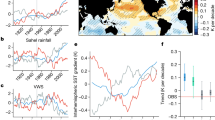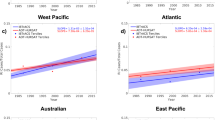Abstract
The frequency of tropical storms in the North Atlantic region varies markedly on decadal timescales1,2,3,4, with profound socio-economic impacts5,6. Climate models largely reproduce the observed variability when forced by observed sea surface temperatures1,8,10. However, the relative importance of natural variability and external influences such as greenhouse gases, dust, sulphate and volcanic aerosols on sea surface temperatures, and hence tropical storms, is highly uncertain11,12,13,14,15,16. Here, we assess the effect of individual climate drivers on the frequency of North Atlantic tropical storms between 1860 and 2050, using simulations from a collection of climate models17. We show that anthropogenic aerosols lowered the frequency of tropical storms over the twentieth century. However, sharp declines in anthropogenic aerosol levels over the North Atlantic at the end of the twentieth century allowed the frequency of tropical storms to increase. In simulations with a model that comprehensively incorporates aerosol effects (HadGEM2-ES; ref. 18), decadal variability in tropical storm frequency is well reproduced through aerosol-induced north–south shifts in the Hadley circulation. However, this mechanism changes in future projections. Our results raise the possibility that external factors, particularly anthropogenic aerosols, could be the dominant cause of historical tropical storm variability, and highlight the potential importance of future changes in aerosol emissions.
This is a preview of subscription content, access via your institution
Access options
Subscribe to this journal
Receive 12 print issues and online access
$259.00 per year
only $21.58 per issue
Buy this article
- Purchase on Springer Link
- Instant access to full article PDF
Prices may be subject to local taxes which are calculated during checkout




Similar content being viewed by others
References
Knutson, T. R. et al. Tropical cyclones and climate change. Nature Geosci. 3, 157–163 (2010).
Goldenberg, S. I., Landsea, C. W., Mestas-Nuñez, A. M. & Gray, W. M. The recent increase in Atlantic hurricane activity: Causes and implications. Science 293, 474–479 (2001).
Klotzbach, P. J. & Gray, W. M. Multidecadal variability in North Atlantic tropical cyclone activity. J. Clim. 21, 3929–3935 (2008).
Nigam, S. & Guan, B. Atlantic tropical cyclones in the twentieth century: Natural variability and secular change in cyclone count. Clim. Dynam. 36, 2279–2293 (2011).
Rappaport, E. N. Loss of life in the United States associated with recent Atlantic tropical cyclones. Bull. Am. Meteorol. Soc. 81, 2065–2073 (2000).
Pielke, R. A. et al. Normalized hurricane damage in the United States: 1900–2005. Nat. Hazards Rev. 9, 29–42 (2008).
Smith, D. M. et al. Skilful multi-year predictions of Atlantic hurricane frequency. Nature Geosci. 3, 846–849 (2010).
Zhao, M. & Held, I. M. TC-permitting GCM simulations of hurricane frequency response to sea surface temperature anomalies projected for the late-twenty-first century. J. Clim. 25, 2995–3009 (2012).
Villarini, G. & Vecchi, G. A. Twenty-first-century projections of North Atlantic tropical storms from CMIP5 models. Nature Clim. 2, 604–607 (2012).
Zhang, R. & Delworth, T. L. Impact of Atlantic Multidecadal oscillations on India/Sahel rainfall and Atlantic hurricanes. Geophys. Res. Lett. 33, L17712 (2006).
Ting, M., Kushnir, Y., Seager, R. & Li, C. Forced and internal twentieth-century SST trends in the North Atlantic. J. Clim. 22, 1469–1481 (2009).
Otterå, O. H., Bentsen, M., Drange, H. & Suo, L. External forcing as a metronome for Atlantic multidecadal variability. Nature Geosci. 3, 688–694 (2010).
Booth, B. B. B., Dunstone, N. J., Halloran, P. R., Andrews, T. & Bellouin, N. Aerosols implicated as a prime driver of twentieth-century North Atlantic climate variability. Nature 484, 228–232 (2012).
Mann, M. E. & Emanuel, K. A. Atlantic hurricane trends linked to climate change. Eos, Trans. Am. Geophys. Union 87, 233–244 (2006).
Wang, C, Dong, S, Evan, A. T., Foltz, G. R. & Lee, S-K. Multidecadal covariability of North Atlantic sea surface temperature, African dust, Sahel rainfall, and Atlantic hurricanes. J. Clim. 25, 5404–5415 (2012).
Evan, A. T. Atlantic hurricane activity following two major volcanic eruptions. J. Geophys. Res. 117, D06101 (2012).
Taylor, K. E., Stouffer, R. J. & Meehl, G. A. An Overview of CMIP5 and the experiment design. BAMS 93, 485–498 (2012).
Collins, W. J. et al. Development and evaluation of an Earth-System model-HadGEM2. Geosci. Model Dev. 4, 1051–1075 (2011).
Latif, M. N., Keenlyside, N. & Bader, J. Tropical sea surface temperature, vertical wind shear, and hurricane development. Geophys. Rev. Lett. 34, L01710 (2007).
Bellouin, N. et al. Aerosol forcing in the Climate Model Intercomparison Project (CMIP5) simulations by HadGEM2-ES and the role of ammonium nitrate. J. Geophys. Res. 116, D20206 (2011).
Clement, A. C., Burgman, R. & Norris, J. R. Observational and model evidence for positive low-level cloud feedback. Science 325, 460–464 (2009).
Kang, S. M., Held, I. M., Frierson, D. M. W. & Zhao, M. The response of the ITCZ to extratropical thermal forcing: Idealized slab-ocean experiments with a GCM. J. Clim. 21, 3521–3532 (2008).
Dunstone, N. J., Smith, D. M. & Eade, R. Multi-year predictability of the tropical Atlantic atmosphere driven by the high latitude North Atlantic Ocean. Geophys. Res. Lett. 38, L14701 (2011).
Chang, C. Y., Chiang, J. C. H., Wehner, M. F., Friedman, A. & Ruedy, R. Sulfate aerosol control of tropical Atlantic climate over the 20th century. J. Clim. 24, 2540–2555 (2011).
Vimont, D. J. & Kossin, J. P. The Atlantic Meridional Mode and hurricane activity. Geophys. Res. Lett. 34, L07709 (2007).
Allen, R. J., Sherwood, S. C., Norris, J. R. & Zender, C. S. Recent North Hemisphere tropical expansion primarily driven by black carbon and tropospheric ozone. Nature 485, 350–354 (2012).
Landsea, C. W., Vecchi, G. A., Bengtsson, L. & Knutson, T. R. Impact of duration threshold on Atlantic tropical cyclone counts. J. Clim. 23, 2508–2519 (2010).
Rayner, N. A. et al. Global analyses of sea surface temperature, sea ice, and night marine air temperature since the late nineteenth century. J. Geophys. Res. 108, 4407 (2003).
Compo, G. L. et al. The twentieth century reanalysis project. Quart. J. R. Meteorol. Soc. 137, 1–28 (2011).
Acknowledgements
We are very grateful for discussion and input from N. Bellouin. We also thank G. Jones, P. Halloran and J. Hughes for setting up and running the CMIP5 integrations of HadGEM2-ES. We acknowledge the modelling groups, the Program for Climate Model Diagnosis and Intercomparison (PCMDI) and the World Climate Research Programme’s Working Group on Coupled Modelling (WGCM), which is responsible for CMIP, and we thank the climate modelling groups (listed in Supplementary Fig. S5 of this paper) for producing and making available their model output. For CMIP the US Department of Energy’s Program for Climate Model Diagnosis and Intercomparison provides coordinating support and led development of software infrastructure in partnership with the Global Organization for Earth System Science Portals. The authors were supported by the Joint DECC/Defra Met Office Hadley Centre Climate Programme (GA01101) and the EU FP7 THOR project.
Author information
Authors and Affiliations
Contributions
N.J.D. and D.M.S. led the analysis. N.J.D., D.M.S., B.B.B.B. and L.H. wrote the paper. R.E. performed the storm tracking and commented on the manuscript.
Corresponding author
Ethics declarations
Competing interests
The authors declare no competing financial interests.
Supplementary information
Supplementary Information
Supplementary Information (PDF 3947 kb)
Rights and permissions
About this article
Cite this article
Dunstone, N., Smith, D., Booth, B. et al. Anthropogenic aerosol forcing of Atlantic tropical storms. Nature Geosci 6, 534–539 (2013). https://doi.org/10.1038/ngeo1854
Received:
Accepted:
Published:
Issue Date:
DOI: https://doi.org/10.1038/ngeo1854
This article is cited by
-
Tropical Atlantic multidecadal variability is dominated by external forcing
Nature (2023)
-
Evolution characteristics of the Atlantic Meridional Overturning Circulation and its thermodynamic and dynamic effects on surface air temperature in the Northern Hemisphere
Science China Earth Sciences (2023)
-
Natural and anthropogenic contributions to the hurricane drought of the 1970s–1980s
Nature Communications (2022)
-
Dynamical downscaling projections of late twenty-first-century U.S. landfalling hurricane activity
Climatic Change (2022)
-
Recent Decrease in the Difference in Tropical Cyclone Occurrence between the Atlantic and the Western North Pacific
Advances in Atmospheric Sciences (2022)



